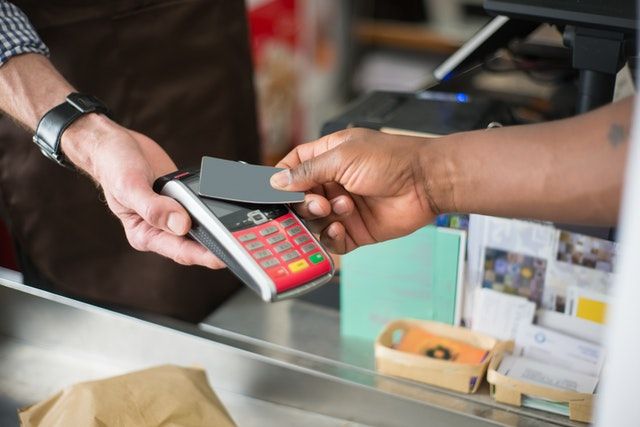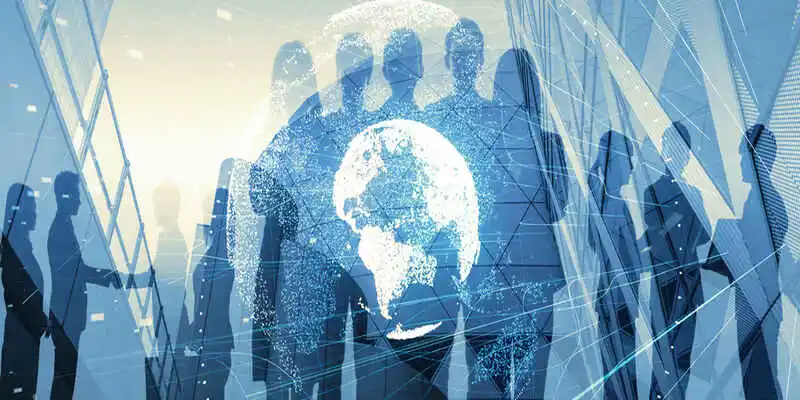Artificial Intelligence and Machine Learning Grocery Potentials
Artificial intelligence and machine learning grocery technology leverage readily available consumer data and product information to accelerate business growth shortly than predicted. Using ML, grocers use lean technology to build consumer relationships and tackle big business threats and obstacles.

Artificial intelligence and machine learning changed the fundaments of retail operations. It combines cutting-edge technologies to allow machines to think, understand, and execute operations in a humanoid manner. Before entering details of the future of the grocery market with machine learning, let's differentiate between artificial intelligence and machine learning:
- Artificial intelligence (AI) helps shoppers get precisely what they are searching for in a completely automated way. It performs things beyond human access, for instance, analyzing a more considerable amount of data to predict issues and results correctly.
- Machine learning (ML) is a highly famous term in the retail industry as it considers limitless historical data lines and finds relevant patterns and trends to make accurate predictions.
Retailers are now interested in introducing outstanding grocery experiences for their quality customers in various ways, including personalized recommendations, promotions, offerings, and increasing trust, among many others. Artificial intelligence and machine learning grocery technology use abundantly available customer data and product information to boost business growth in less than expected tenure. Grocers' lean technology to strengthen customer relations and overcome major business threats and challenges using ML analytics and capabilities.
Artificial Intelligence in Retail Statistics
Machine learning grocery offers a highly personalized experience to the customers and provides them with an interactive environment. IBM Corporation forecasts that the introduction of AI in retail will leap from 40% (currently) to over 80% in the next three years. Besides, Juniper reported that the investment in AI by global retailers is forecasted to approach $7.3 billion by 2022 annually ($2 billion was expected in 2018).
The food department, including grocery and apparel stores, warm-welcome AI innovations. Only 26% of ML solutions in the retail industry interact with customers directly, while the remaining are behind the scenes. The significant involvement of technology is to take control of repetitive routine tasks, but it will find more ways to support humanity in the coming years with more exposure to its potential.
The Rise of the Digital Shopper in Grocery
The peak of technology involvement in grocery was observed when the pandemic arose, which paralyzed daily physical operations. Businesses shifted their physical stores to online marketplaces to sustain their presence; for it, they sued technology to develop online applications, and consumers installed them and became adaptive to this advancement. It is predicted that people will continue with this innovation because they find it more personalized and hassle-free. However, it also increased competition among grocery retailers; only those with advanced machine learning grocery solutions can lead the market.
Localization and Zip-Code Level Customization
The major shift in the food retail industry is based on the preferences and changes in the local food movement. Increased shoppers support local farmers by seeking local food, resultantly reducing the environmental impacts of long-distant food transportation. Local food authorities should assign local food managers to find, validate, and test locally produced food to support local food-producing businesses. Machine-based recommendations enable grocery retailers to share highly customized experiences for zip-code level price tracking. They must track assortments at the local level to boost sales exceptionally.
Machine Learning Grocery Potentials in 2022
1. Pricing and Promotions
AI provides deeper analytics about contexts and intents behind a customers’ shopping decisions. It uses tactics to subdivide customers based on several variables for grocers to collect information about their audience's brand preferences. Now this available information is used to conduct promotions and campaigns to target the right audience. Plus, it helps grocers parse customer data and automatically offer targeted campaigns to them.
2. Personalization
The grocers take personalization as a challenge to please their tech-savvy customers via machine learning, big data, and intelligent solutions. They prepare models to understand better a customer's behavior through their searching history, social interactions, page clicks, last purchase, location, and page views. These share product recommendations based on related items they just added to their wish-list and customized their page feed matching with the needs.
3. Enriching In-Store Experience
AI-powered technology is committed to offering customers with locating products in nearby stores in real-time on their smartphones by sending notifications. It improves customer experience and aids them in deciding what they should buy in their budget. Moreover, these technology help grocers understand the product their customers love and bring them to their store. Next time, they suggest similar products to improve their shopping experience and keep them engaged.
4. Real-Time Consumer and Competitor Analysis
The online demand for groceries and food was enhanced during the COVID-19 session, and during this time, many grocers engaged customers via artificial intelligence and machine learning grocery potentials. AI-driven solutions play a critical role in boosting conversions and earning high profits by getting insights about customers in real-time. Retailers can also analyze their competitor's deals daily or even on an hourly basis to adjust their prices and promotions accordingly.
5. Theft Prevention via a Machine Vision System
It is one of the significant issues stores face due to shoplifting customers. ShopLift, a Massachusetts-based company offered a machine vision system to reduce theft activities at retail. Its product, ScanItAll, is a checkout vision system that detects sweethearting (checkout errors) at grocery counters. A cashier does sweethearting in favor of a customer that might be his friend or fellow employee in scanning a product fake at checkouts.
The computer vision technology introduced by ScanItAll is compatible with the store’s already on-job video cameras and POS (point-of-sale) systems. The software uses a camera to watch if the cahier scans all products on the counter and recognizes products without checking at the POS and claims it a loss. The system is efficient enough to detect bar code covering strategies, stacking items, and skipping the scanner. Piggly Wiggly supermarkets reported losses of about $6000 to $10000 monthly due to checkout shrinkage as a result of sweethearting. However, the company declined shrinkage to $1000 after installing StopLift. Big Y, the US grocer, deployed this system in 35/56 stores to check the performance of their cashiers.
6. Innovation in Fulfilment and Supply Chain
US citizens like to buy online still in the post-pandemic situation, but the supply chains are deficient at adapting technology quickly or responding to a crisis. These legacy verticals are too complex to meet the rising customer demands, lacking transparency and predicting based on only historical data.
Grocers should go ahead with this vertical supply chain system to manage product assortments, speed processes, and improve lead time. They must offer free delivery products on the same ordered day, which is possible only by investing in AI-powered solutions. Artificial intelligence and machine learning grocery potentials can save food wastage and stock outs by forecasting demands and maintaining supplies.
7. Cashier-Free Payments
People are too busy and don’t like standing in lines for groceries; the grocers introduce a cashier-less grocery experience via artificial intelligence. It also uses video analytics to better understand customer behavior, for instance, Amazon Go; Hawkins said:
“Amazon’s AI-powered capability ingests all the feed from cameras, shelf sensors, and other technology to understand the specific items customers walk out the door with”
H-E-B Go, H-E-B debuted a self-checkout app that has grown to seven shops, while Scan, Bag, Go technology has expanded to 400 stores in 2018. Walmart in China has established an exceptional market in Shenzhen, where clients utilize WeChat to pay their bills via mobile devices. A hologram greeted them when they entered through the smartphone app, customers shop with an intelligent basket where Moby deducts the amount when they leave automatically.
8. Inventory Forecasting and Reduction in Food Wastage
FAO reported that the food waste costs $680 billion in developed nations and $310 billion in underdeveloped countries. In 2010, the US alone's food stuff wastage at the consumer and retailer level was 133 billion pounds.
Afresh Technologies developed an AI-powered application for grocers to forecast customer demands and inventory replacement solutions by considering these numbers. The company claims its app is mainly designed to reduce food wastage on a larger scale, enhancing the availability of fresh food that is directly related to customer satisfaction. The CEO of the company, Matt Schwartz, committed in a Future Food SF Presentation that their app is based on deep learning algorithms to process layer by layer data points and forecast demand per item. After predicting accurately, the app suggests several items be replaced in inventory and integrated automatically into the workflow. Plus, the company claims that 50% less waste and 80% fewer stock-out situations can be attained after implementing its solutions.
9. The Tailored Ads
Every digital technology user is considered a single entity, and what he sees is based on his interests; a similar phenomenon is now introduced in grocery stores. Tailored solutions give shoppers highly valued on an individual scale, making grocery quick and more accessible.
Food retailers started understanding that it would help create a database regarding a customer, for instance, what he loves to buy and how his grocery patterns change over time. Then AI uses this information to show similar products to the customers and attract them to the retail shop, so they buy another item and stay attached to their business. Hawkins explained:
“We are talking massive volumes of data, which is an environment AI is made for. A human being cannot begin to tackle that.”
He added more
“This AI technology can go incredibly deep and continues to learn over time, so, it gets better at knowing which items to promote at which price. This will likely lead to different prices for different people, thanks to offer they are sent.”
The director of research at “Coca-Cola Retailing Research Councils of North America (CCRRC)”, Michael Sansolo, shared his thoughts that personalization can bring innovation to grocery stores. Technology will help understand dietary preferences individually, including which recipes they prefer and which foods they avoid. After finding data, a handheld device can be used to show them relevant products on sale.
Kroger leverages smart-shelve innovation; when consumers use the cell phone app in its retailers, sensors identify and share tailored product selection and pricing solutions through shelf displays or devices. The technology offers personalized solutions even based on their shopping speed (quick/slow) and their needs (via video or text messages). Sansolo explained:
“It is about being relevant not to today’s shopper but to tomorrows. The key with technology is that it has to serve the customer’s needs. It’s going to be about experience and delighting the customers.”
McMillan Doolittle’s Devitt thinks that artificial intelligence and machine learning grocery potentials might take innovation to the next level, forecasting the customer's grocery needs and telling them what it guessed and then receiving “Order Placed” notification from the customer with five-star reviews on exceptional services.
10. Friendly Prices for Value-Sensitive Digital Customers
To respond to today's highly aware and price-sensitive customers, grocers will require pricing intelligence to give the most significant discounts without jeopardizing their product margins. Unlike in a traditional store, where pricing might remain constant for days or even weeks, prices can fluctuate quickly while purchasing online. Every 2 minutes, Amazon utilizes its dynamic pricing algorithms to check the cost of millions of its SKUs, including groceries. AI-driven dynamic and competitive pricing tools will be the only method to optimize price in this fast-paced eCommerce market since humans cannot make judgments quickly enough across thousands of SKUs.
Furthermore, merchants will use AI to produce winning assortments by analyzing ever-changing buying habits and customer demographics and delivering the optimal mix of varieties at all times. With AI assortment intelligence, retailers will be able to monitor comparable goods throughout their competitive landscape and make intelligent selection decisions based on competitive data.
5 Exceptional Grocery Store Robots that You Must Know
Automation and robots are of other level innovation in improving workforce efficiency and hygiene at grocery stores. These robots in the grocery department help track inventory and serve buyers. Here is the list of 5 top grocery store robots you must know.
- Marty: Marty is one of the most famous grocery robots developed by Badger Technologies. It can communicate in English and Spanish with shoppers and alerts them to potential hazards. It has the power to discover about 40 spills per day in each store across 12 sessions and scan the surrounding.
- Tally: It is next to the Marty robot in grocery stores for monitoring shelves. It alerts the workforce about out-of-stock products and other related problems. It collects store data and informs employees about restocking the products.
- Alphabot: Walmart works based on this robot that comes third in the top 5 grocery robots. It involves speeding up the customer’s order accomplishment. It can also climb up to three-story buildings to approach stored products and roll across the rails around storage bins.
- Millie: It functions like Marty, which detects hazards and alerts the workforce on leaks.
- SmartSight EMA50 helps avoid issues regarding out-of-stock products and alerts staff by sending them notifications.
Artificial Intelligence is Crucial for Grocery Business
Artificial intelligence solutions are the future of providing an exceptional customer experience. Brands that focus on implementing AI technology will stand out as more personalized and efficient in the long list of service providers. Artificial intelligence and machine learning grocery automate employees’ tasks sparing their time interacting with customers in other meaningful ways. In grocery’s future, many robots, apps, and technologies will be introduced that are not developed yet. The grocer will establish a balance between human interaction and technology as buyers always prefer to talk with real humans and use an app or chatbot services. For instance, talking with a stylist to get highly personalized product suggestions or asking other complicated queries beyond technological reach.
The Future of Machine Learning Grocery
Machine learning has significant applications in the retail industry. Many retailers strive to introduce ML solutions in their businesses to share highly tailored shopping experiences with their valuable clients. Karen Katz, CEO, and Chief at “Neiman Marcus Group” said:
“Great customer experience will come from blending technology with a more personalized touch. I think the people that can combine technology-powered personalization with a human will be the winners.”
For example, 35% of Amazon’s trades come from ML-based product endorsements customized per purchaser. Also, it is reported that the brands offering personalized solutions are more likely to get repetitive buyer visits than others who ignore this opportunity.
The grocery store is one of the most popular places people visit these days. We can easily run out of food at home and, with a few clicks, have it delivered to our doorsteps or even get it for pick-up. But now, we don't have to leave the comforts of our homes to do something as mundane as shopping for groceries anymore. Artificial intelligence and machine learning grocery technology strengthen customer relations and overcome major business threats and challenges.


